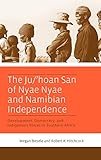The Ju/’hoan San of Nyae Nyae and Namibian Independence : Development, Democracy, and Indigenous Voices in Southern Africa / Megan Biesele, Robert K. Hitchcock.
Material type: TextPublisher: New York ; Oxford : Berghahn Books, [2010]Copyright date: ©2011Description: 1 online resource (308 p.)Content type:
TextPublisher: New York ; Oxford : Berghahn Books, [2010]Copyright date: ©2011Description: 1 online resource (308 p.)Content type: - 9781845457549
- 9781845459970
- 305.896/1 22/eng
- DT1558.K85
- online - DeGruyter
| Item type | Current library | Call number | URL | Status | Notes | Barcode | |
|---|---|---|---|---|---|---|---|
 eBook
eBook
|
Biblioteca "Angelicum" Pont. Univ. S.Tommaso d'Aquino Nuvola online | online - DeGruyter (Browse shelf(Opens below)) | Online access | Not for loan (Accesso limitato) | Accesso per gli utenti autorizzati / Access for authorized users | (dgr)9781845459970 |
Frontmatter -- Contents -- Illustrations -- Preface -- Acknowledgments -- Abbreviations -- Note on Orthography -- Chronology of the Nyae Nyae Region -- Introduction A Community History -- Chapter One Namibia and the Nyae Nyae Region -- Chapter Two Traditional Ju/’hoan Leadership and Governance -- Chapter Three The Ju/’hoan People’s Organization and Its Foundation -- Chapter Four Ju/’hoan Empowerment from Dialogue on Wildlife Issues -- Chapter Five The Lead-Up to Namibian Independence in Nyae Nyae -- Chapter Six Independence The Years of Hope -- Chapter Seven The Nyae Nyae Development Foundation of Namibia -- Chapter Eight The Nyae Nyae Farmers Cooperative after Independence -- Chapter Nine Community-Based Natural Resource Management and Other Development Models -- Chapter Ten Nyae Nyae Conservancy Programs and the Future -- References -- Index
restricted access online access with authorization star
http://purl.org/coar/access_right/c_16ec
The Ju/’hoan San, or Ju/’hoansi, of Namibia and Botswana are perhaps the most fully described indigenous people in all of anthropology. This is the story of how this group of former hunter-gatherers, speaking an exotic click language, formed a grassroots movement that led them to become a dynamic part of the new nation that grew from the ashes of apartheid South West Africa. While coverage of this group in the writings of Richard Lee, Lorna Marshall, Elizabeth Marshall Thomas, and films by John Marshall includes extensive information on their traditional ways of life, this book continues the story as it has unfolded since 1990. Peopled with accounts of and from contemporary Ju›/’hoan people, the book gives newly-literate Ju/’hoansi the chance to address the world with their own voices. In doing so, the images and myths of the Ju/’hoan and other San (previously called “Bushmen”) as either noble savages or helpless victims are discredited. This important book demonstrates the responsiveness of current anthropological advocacy to the aspirations of one of the best-known indigenous societies.
Mode of access: Internet via World Wide Web.
In English.
Description based on online resource; title from PDF title page (publisher's Web site, viewed 25. Jun 2024)


